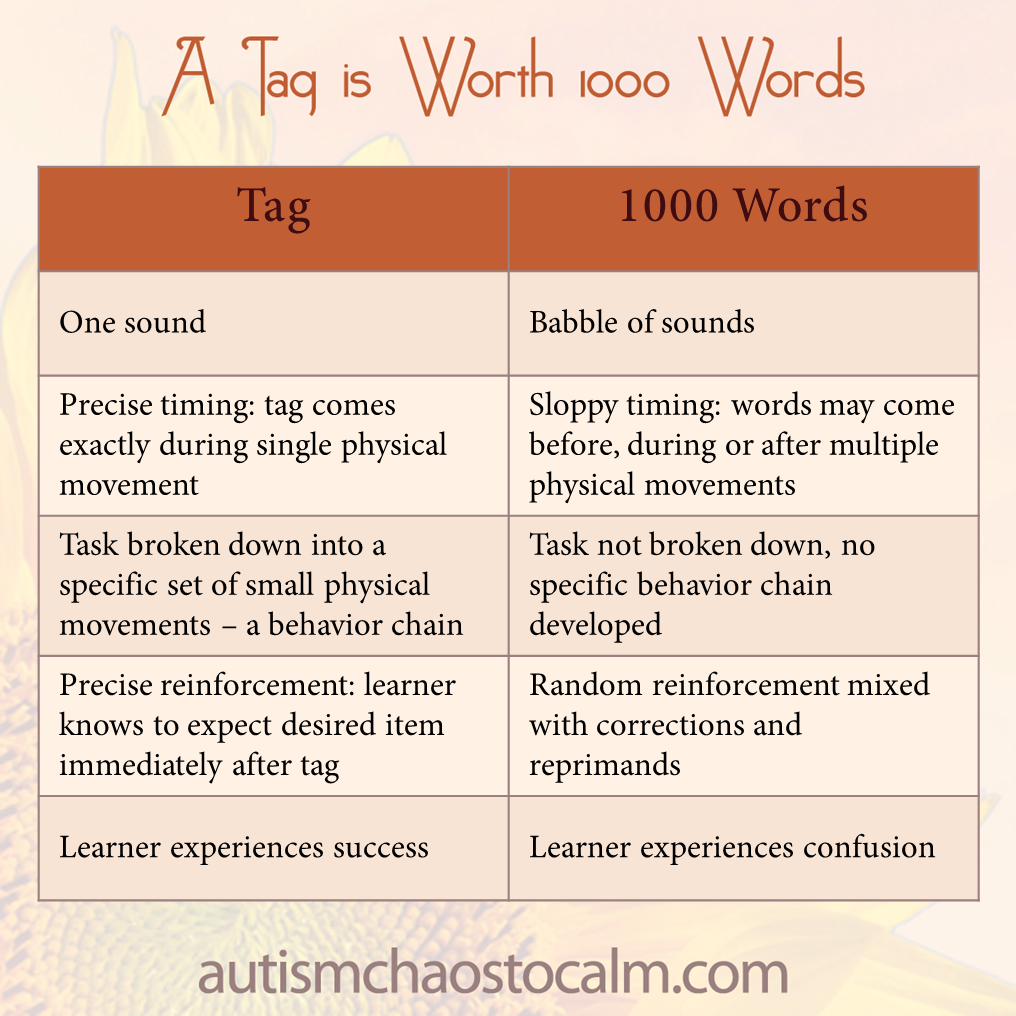Part 1: It is ONE SOUND for ONE MOVEMENT
We’ve all head that a picture is worth a thousand words. The idea that a click is worth a thousand words may be new. Let’s compare a click with a thousand words and see which is better for teaching a child, particularly a child with autism.
The click I’m talking about is also known as a “tag.” It is the key feature of a method called TAGteach, Teaching with Acoustical Guidance. The chart below shows six ways that the click is different from a thousand words. This post will address the first feature: One Sound versus Babble of Sounds.
ONE SOUND
Let’s look at the first feature: a click (tag) is ONE SOUND. It is easy to hear and distinguish one single sound. A thousand words (or even just ten or twenty words) can be a confusing babble to a child with autism. Even if verbal, a child with autism may have difficulty understanding or complying with our words, instructions and warnings.
The click (tag) is always the same sound and it always means the same thing: Success and Reinforcement. The child knows he has achieved something (the tag point) and that he will get a reward. This process makes it easy for him to learn: just pay attention to the click and do that action more often! One sound, one meaning, one outcome (success). This consistency really helps a child with autism. Here’s an example.
USING ONE SOUND TO TEACH SAFE WALKING
With TAGteach, I was able to teach my son a valuable skill: walking safely out-of-doors, something I was not able to do before when I was using words. When he was younger, it took two people to watch my son outside because we never knew when or where he would bolt; it was always dangerous and nerve-wracking to take him out. Using the “tag” he changed from being unsafe outside to being able to go for five mile hikes in wilderness settings,safely and happily.
 BENEFITS OF ONE SOUND FOR ONE PHYSICAL MOVEMENT
BENEFITS OF ONE SOUND FOR ONE PHYSICAL MOVEMENT
The benefit of ONE SOUND was apparent right from the beginning. I had observed my son’s bolting behavior, and noticed that he did not take more than one or two steps in the same direction. He would constantly step, spin and bolt, step, spin and bolt. The constant changes of direction made his movements unpredictable. After watching this, I set the first tag point of “Two Steps in Same Direction.” I watched my son’s feet. Whenever, by chance, he took two steps in the same direction, I tagged and handed him a treat.
The ONE SOUND of the tagger “marked” the exact physical movement of taking the second step in the same direction as the first step. I didn’t explain with words, “Look, walk straight ahead and put one foot in front of the other. Don’t turn to the right or left. Go straight ahead.” He would not have been able to understand or comply with that string of 23 words. With the click, he figured out very quickly that taking two steps in the same direction was a really great thing to do! Since he was reinforced every time he took two steps, he performed that behavior more often! The click did the job that the words had failed to do. The click was much better than even one word.
Next time: More about Precise Timing versus Sloppy Timing.
What is TAGteach?
TAGteach stands for Teaching with Acoustical Guidance. TAGteach is a teaching and communication method based on the scientific principles of Applied Behavior Analysis (ABA).
TAGteach enables extremely precise positive reinforcement of behavior by using an acoustical signal to “mark” the behavior – at the precise moment the child performs the behavior! The acoustical signal is a short, sharp sound made by a handheld device (the “tagger”). When the child performs the correct action, the parent/instructor immediately presses the button on the tagger and hands over a treat (candy, treat, token, praise, social recognition, or money) as a reinforcer.
With TAGteach, it is easy to reinforce behaviors precisely and quickly. The immediate, accurate feedback and positive reinforcement result in the child performing the correct action more often, and for longer periods of time. With immediate feedback and learning tasks broken down into small steps, children can learn many new skills with TAGteach — at their own pace.
 Check out the TAGteach International website
Check out the TAGteach International website
Join the free TAGteach listserve.
TAGteach taggers are available here.
See Martha’s book about TAGteach for Autism or ask a question (with no obligation).
Sign up for my mailing list to receive updates, new articles and free tips right in your inbox!
If you liked this post, please share it on social media via the vertical gray menu on the far right. Thank you!
